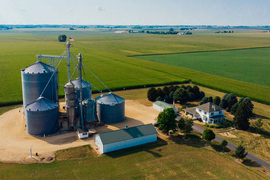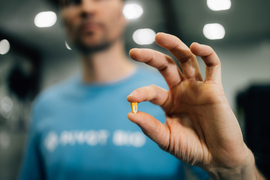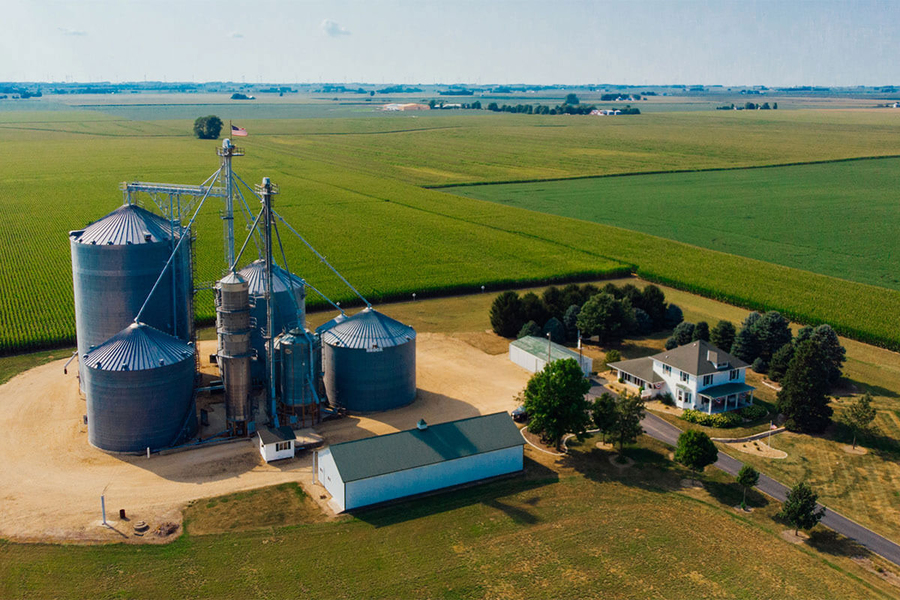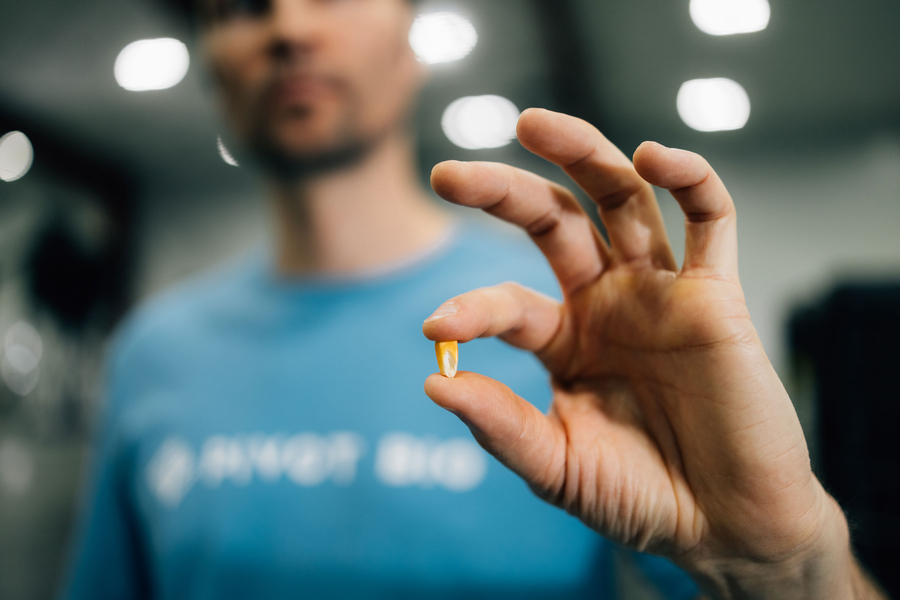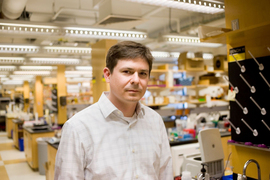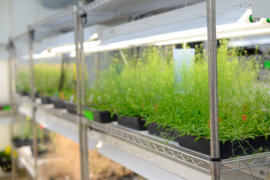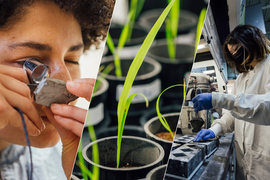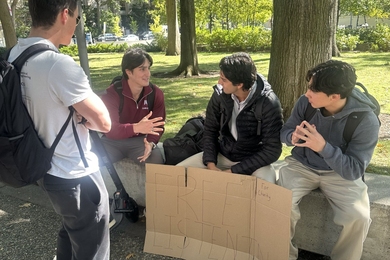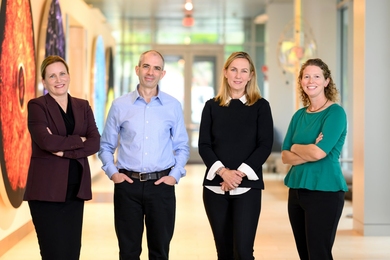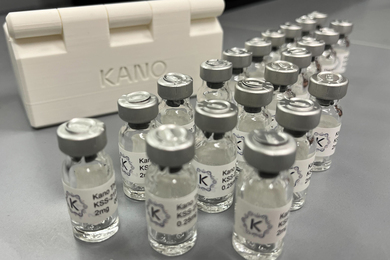The Haber-Bosch process, which converts atmospheric nitrogen to make ammonia fertilizer, revolutionized agriculture and helped feed the world’s growing population, but it also created huge environmental problems. It is one of the most energy-intensive chemical processes in the world, responsible for 1-2 percent of global energy consumption. It also releases nitrous oxide, a potent greenhouse gas that harms the ozone layer. Excess nitrogen also routinely runs off farms into waterways, harming marine life and polluting groundwater.
In place of synthetic fertilizer, Pivot Bio has engineered nitrogen-producing microbes to make farming more sustainable. The company, which was co-founded by Professor Chris Voigt, Karsten Temme, and Alvin Tamsir, has engineered its microbes to grow on plant roots, where they feed on the root’s sugars and precisely deliver nitrogen in return.
Pivot’s microbial colonies grow with the plant and produce more nitrogen at exactly the time the plant needs it, minimizing nitrogen runoff.
“The way we have delivered nutrients to support plant growth historically is fertilizer, but that’s an inefficient way to get all the nutrients you need,” says Temme, Pivot’s chief innovation officer. “We have the ability now to help farmers be more efficient and productive with microbes.”
Farmers can replace up to 40 pounds per acre of traditional nitrogen with Pivot’s product, which amounts to about a quarter of the total nitrogen needed for a crop like corn.
Pivot’s products are already being used to grow corn, wheat, barley, oats, and other grains across millions of acres of American farmland, eliminating hundreds of thousands of tons of CO2 equivalent in the process. The company’s impact is even more striking given its unlikely origins, which trace back to one of the most challenging times of Voigt’s career.
A Pivot from despair
The beginning of every faculty member’s career can be a sink-or-swim moment, and by Voigt’s own account, he was drowning. As a freshly minted assistant professor at the University of California at San Francisco, Voigt was struggling to stand up his lab, attract funding, and get experiments started.
Around 2008, Voigt joined a research group out of the University of California at Berkeley that was writing a grant proposal focused on photovoltaic materials. His initial role was minor, but a senior researcher pulled out of the group a week before the proposal had to be submitted, so Voigt stepped up.
“I said ‘I’ll finish this section in a week,’” Voigt recalls. “It was my big chance.”
For the proposal, Voigt detailed an ambitious plan to rearrange the genetics of biologic photosynthetic systems to make them more efficient. He barely submitted it in time.
A few months went by, then the proposal reviews finally came back. Voigt hurried to the meeting with some of the most senior researchers at UC Berkeley to discuss the responses.
“My part of the proposal got completely slammed,” Voigt says. “There were something like 15 reviews on it — they were longer than the actual grant — and it’s just one after another tearing into my proposal. All the most famous people are in this meeting, future energy secretaries, future leaders of the university, and it was totally embarrassing. After that meeting, I was considering leaving academia.”
A few discouraging months later, Voigt got a call from Paul Ludden, the dean of the School of Science at UC Berkeley. He wanted to talk.
“As I walk into Paul’s office, he’s reading my proposal,” Voigt recalls. “He sits me down and says, ‘Everybody’s telling me how terrible this is.’ I’m thinking, ‘Oh my God.’ But then he says, ‘I think there’s something here. Your idea is good, you just picked the wrong system.’”
Ludden went on to explain to Voigt that he should apply his gene-swapping idea to nitrogen fixation. He even offered to send Voigt a postdoc from his lab, Dehua Zhao, to help. Voigt paired Zhao with Temme, and sure enough, the resulting 2011 paper of their work was well-received by the nitrogen fixation community.
“Nitrogen fixation has been a holy grail for scientists, agronomists, and farmers for almost a century, ever since somebody discovered the first microbe that can fix nitrogen for legumes like soybeans,” Temme says. “Everybody always said that someday we'll be able to do this for the cereal crops. The excitement with Pivot was this is the first time that technology became accessible.”
Voigt had moved to MIT in 2010. When the paper came out, he founded Pivot Bio with Temme and another Berkeley researcher, Alvin Tamsir. Since then, Voigt, who is the Daniel I.C. Wang Professor at MIT and the head of the Department of Biological Engineering, has continued collaborating with Pivot on things like increasing nitrogen production, making strains more stable, and making them inducible to different signals from the plant. Pivot has licensed technology from MIT, and the research has also received support from MIT’s Abdul Latif Jameel Water and Food Systems Lab (J-WAFS).
Pivot’s first goals were to gain regulatory approval and prove themselves in the marketplace. To gain approval in the U.S., Pivot’s team focused on using DNA from within the same organism rather than bringing in totally new DNA, which simplified the approval process. It also partnered with independent corn seed dealers to get its product to farms. Early deployments occurred in 2019.
Farmers apply Pivot’s product at planting, either as a liquid that gets sprayed on the soil or as a dry powder that is rehydrated and applied to the seeds as a coating. The microbes live on the surface of the growing root system, eating plant sugars and releasing nitrogen throughout the plant’s life cycle.
“Today, our microbes colonize just a fraction of the total sugars provided by the plant,” Temme explains. “They’re also sharing ammonia with the plant, and all of those things are just a portion of what’s possible technically. Our team is always trying to figure out how to make those microbes more efficient at getting the energy they need to grow or at fixing nitrogen and sharing it with the crop.”
In 2023, Pivot started the N-Ovator program to connect companies with growers who practice sustainable farming using Pivot’s microbial nitrogen. Through the program, companies buy nitrogen credits and farmers can get paid by verifying their practices. The program was named one of the Inventions of the Year by Time Magazine last year and has paid out millions of dollars to farmers to date.
Microbial nitrogen and beyond
Pivot is currently selling to farmers across the U.S. and working with smallholder farmers in Kenya. It’s also hoping to gain approval for its microbial solution in Brazil and Canada, which it hopes will be its next markets.
"How do we get the economics to make sense for everybody — the farmers, our partners, and the company?” Temme says of Pivot’s mission. “Because this truly can be a deflationary technology that upends the very expensive traditional way of making fertilizer.”
Pivot’s team is also extending the product to cotton, and Temme says microbes can be a nitrogen source for any type of plant on the planet. Further down the line, the company believes it can help farmers with other nutrients essential to help their crops grow.
“Now that we’ve established our technology, how can Pivot help farmers overcome all the other limitations they face with crop nutrients to maximize yields?” Temme asks. “That really starts to change the way a farmer thinks about managing the entire acre from a price, productivity, and sustainability perspective.”
